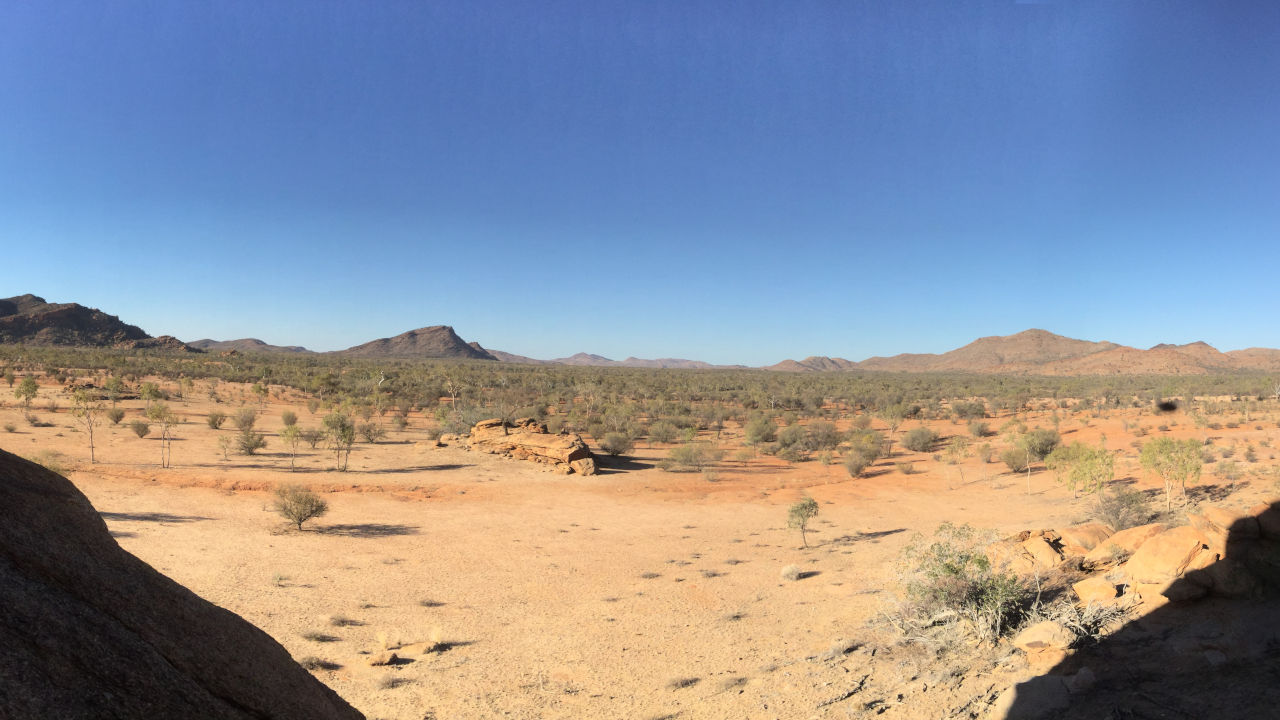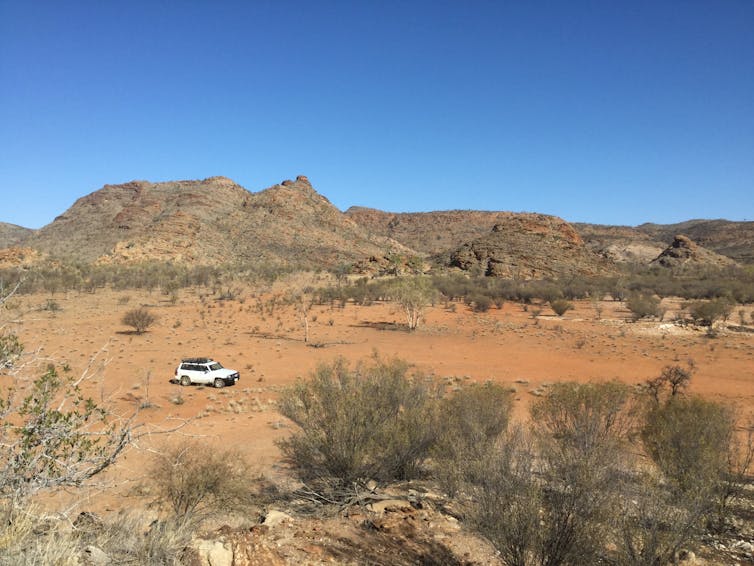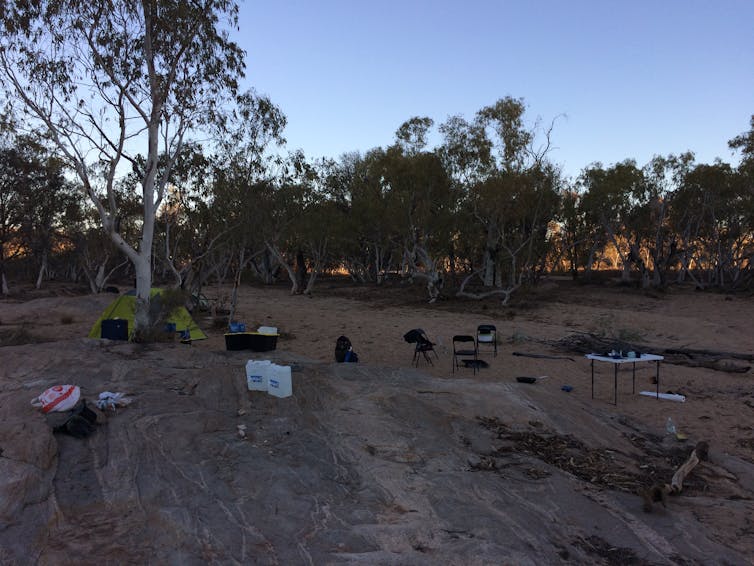Deep in the Australian desert, an expedition in search of rare earths
As a teacher-researcher and geologist for over 20 years, I've had the opportunity to go on numerous field missions during my career. The expedition I'm about to tell you about is my last field mission, back in the old days, pre-pandemic, during the austral winter of 2019.
Bénédicte Cenki, University of Montpellier

As a teacher-researcher and geologist for over 20 years, I've had the opportunity to carry out numerous field missions during my career. Each time with the same passion for discovering new territories, from the Peruvian Altiplano for my master's thesis in 1997 (I travelled in a truck filled with potatoes), to all those years surveying the active quarries of South India for my thesis in the early 2000s, to all those field missions in the mountains (even a Via Ferrata at over 3000 m altitude on Mont-Emilius in Val d'Aoste in 2007) or on heavenly Greek islands where metamorphic rocks (rocks transformed during tectonic processes such as the formation of mountain ranges) plunge into crystal-clear Bahamas-green water.
The expedition I'm about to tell you about is my last field mission, back in the old days, pre-pandemic, during the austral winter of 2019.
The aim of this mission was to study rocks in an area close to Nolans Bore, which in the next few years will be one of Australia's largest rare earth mines in the Northern Territories.
Rare earths such as lanthanum, cerium, praseodymium, neodymium, thulium and ytterbium are essential chemical elements for new technologies (wind turbines, solar panels, electric vehicles).
These metals are considered critical because, combined with their economic importance, their supply is heavily dependent on China.
Why search for rare earths in Central Australia?
To prevent future economic, geopolitical and environmental problems, Western countries have been launching major research projects over the last ten years to diversify their sources of supply and ensure that their extraction is responsible and respectful of men, women and the environment.
See also:
These metals that are running out, a challenge for tomorrow's societies
As the winner of a Marie Curie Horizon 2020 European project, I had the opportunity to spend 18 months as a delegate at the University of Sydney to acquire additional skills in numerical modeling. And I took the opportunity to organize a mission to the Australian desert, known as the bush, to assess the rare earth potential of the pegmatites of the Entia metamorphic dome (circular outcrop of partially molten rocks from the Earth's deep crust during the formation of very ancient mountain ranges) in Central Australia. Pegmatites are melt products of the continental crust, rich in quartz, feldspars and micas, but also in rare metals.
To this end, I invited two colleagues: Patrice Rey, a tectonist and modeler from the University of Sydney, and Fleurice Parat, a magmatic petrologist from the University of Montpellier.
Organize a fully autonomous mission in the Australian bush
This meticulous organization begins several months in advance, as nothing can be left to chance (there will be enough hazards when the time comes anyway). For this mission to be a success, I absolutely must find the GPS coordinates of the rare earth deposits listed in the 1990s archives of the Northern Territory Geological Survey. Indeed, after intensive exploration for uranium at the end of the 20th century, this territory has shown considerable interest in rare earths since the beginning of the 21st century (rare earth minerals are often also radioactive, which also complicates their extraction).
Since we won't have Internet access, I absolutely must prepare this mission "the old-fashioned way": select the targets from reports that are over 30 years old, print out all the satellite images, topographical or geological maps potentially required, buy a solar charger for the GPS and iPad that will enable us to navigate in the bush to reach the geological targets and, of course, think about the Géosciences Montpellier satellite phone and the emergency GPS beacon that will enable us to be found in the event of a serious problem (and make sure to record it before leaving civilization!).
I arrive in Alice Springs from Sydney on the morning of July 11th, almost at the same time as my colleague Fleurice arrives from France after a 24-hour flight. Our colleague Patrice will join us two days later. The two of us are therefore busy planning logistics and essential shopping. We'll be leaving with just one 4×4, so we'll need to stay on the tracks visible from the satellite images, without risking leaving them.

Source, Author provided
Alice Springs is a small town of around 20,000 inhabitants in central Australia, several thousand kilometers from civilization (1,500 km from Darwin to the north and Adelaide to the south). The local supermarket has none of the superfluity of our European hypermarkets or the posh Pacific coast! But the essentials are there: water for 15 days (there's no spring where we're going), pasta, canned vegetables, freeze-dried soups, tea, muesli, spreads, vitamin powder (spirulina type), table, folding chairs and crockery (which we'll leave to the locals after the mission), shovels (to dig the daily and individual toilets), sun cream, big hats and... fly nets! We'll be totally self-sufficient, but at the same time light and minimalist (which reassures me, as my colleague Patrice has many missions in the bush behind him): cooking on the fire (a hearth dug in the sand of the creek), no generator, no fridge, so we'll only be taking food that can be kept at room temperature and, of course, a first-aid kit.
The Entia metamorphic dome is located on the private land of Ambalindum station, a huge cattle farm covering several thousand km2. My requests to the head office in Brisbane for authorization to access it have gone unanswered, so we'll have to negotiate access on the spot with the farmers when the time comes. This means a 300 km detour, without even being sure they'll see us!
So we spend our first three acclimatization nights at the Hale River Homestead campsite in Old Ambalindum (150 km east of Alice Springs). After a quick phone call to the farmer on the second night, she tells me to come by the next day at 7am after their morning debriefing. As the sun rises in a veil of dry red dust, I catch a glimpse of the farmers' helicopter, its spinning blades breaking the icy morning silence. We park in front of the little one-storey shack hosting the morning meeting. We're not invited inside, even though the temperature is only a few degrees. We wait for the farmer to arrive with cards, which we unroll on the hood of the car. She hesitates to give us access authorization, and we repeat that we're not a mining company, but academics. In the end, the sesame was the name of a colleague from the University of Adelaide who came the previous year and had made a good impression. Phew, the mission was saved. We set off for a six-hour drive, entering the Entia dome on a safe, passable track with just one vehicle. Last stop to fill up the diesel tank before the end of civilization: the aboriginal community of Atitjere, remote and so far removed from our Western vision of the world.
Our daily life for 10 days in the heart of the Entia dome
In the late afternoon, we arrive at our campsite, in the heart of the dome, which means we'll be able to radiate daily, in a dry creek that Patrice recognizes from having been here several times before: this corner of rock is the kitchen area (magnificent migmatites!), the sand is the most comfortable for tents and over there are the toilets. Once we've set up camp, we cook our first dinner (ratatouille pasta!) under the stars over a campfire dug into the sand. With a bowl of tea to warm our hands - it's only a few degrees - we enjoy our first evening under the immensity of a magnificent starry sky and in an enveloping, reassuring silence. The second day begins like the next, with the morning ritual at sunrise around 6.30am: Patrice and Fleurice stoke the fire, prepare tea and breakfast while I check that the electronics are charged, establish our itinerary for the day and the order of the geological targets to be visited. It doesn't take long for everyone to find their natural place in this type of mission, and everything runs smoothly and simply.

Source, Author provided
The days go by like clockwork: we get as close as possible to the target points by 4×4, following the tracks visible on Google Earth. Then we set off on foot with water, hammers, field notebooks and GPS to reach the selected outcrop. Fortunately, the vegetation is sparse and thin, and the gradient gentle, allowing us to navigate in a straight line and at sight: the pegmatites are very light-colored rocks, and therefore clearly visible in the monotonous ochre-brown landscape. Once we reach the outcrop, Fleurice and I get out our magnifying glasses to try and spot rare minerals with barbaric names like samarskite, fergussonite and monazite, while Patrice gets out his compass to take measurements and compare the direction of the pegmatites with that of the surrounding rocks. A well-honed, efficient team! These minerals contain heavy rare earths such as thulium and ytterbium (used in superconductors, radiotherapy and infrared lasers), as well as niobium and tantalum (used mainly in aerospace alloys).
One evening, on the way back to camp, Patrice stops the 4×4 near a cattle tank, climbs the few rungs of the ladder and discovers that the trapdoor covering it is open: from now on, we'll be able to collect a jerrycan of water every evening for washing up (and the occasional cup shower, what a luxury!).
Every evening, we return to the field just before dark, at around 6pm, to make the most of the ten or so hours of daylight in the southern winter. The evening ritual is therefore often carried out by headlamp: gathering a few dry grasses to relight the fire, cooking, washing up with a trickle of water, sorting out the day's samples and updating the field notebooks while trying to synthesize all the information and formulate and discuss scientific hypotheses to be tested later. A last look at the Milky Way and the Southern Cross while sipping a cup of tea, before retiring to our tents at around 9pm.

Source, Author provided
The days go by peacefully, and all look the same. It's not until the last afternoon that we have a surprise in store: our first (and last) encounter with the dingo, that famous wild dog icon of the Australian bush. We're at the last outcrop, in the heart of the Inkamulla sub-dome. We discuss the significance of folded structures and try to carefully sample, with chisel and hammer, sections of rock showing folds important for understanding the setting of this geological structure. The evening light makes the red-ochre of the rock even more intense, with its rounded, welcoming and timeless relief.
In fact, it looks like an aboriginal cave, protected from the wild beasts, just a few metres high and easy to climb. A few aboriginal artefacts found in the dust bear witness to this. The shadows of the eucalyptus trees, with their spotted white trunks and light-green leaves, grow longer as the minutes pass. At this peaceful, unreal moment, a dingo nonchalantly approaches our group, discussing our geological sampling technique for these small shear bands that we need to date. Curious, the dingo circles us a few meters away and sits down on a rock to continue observing us.
What's next?
Before taking the plane back to civilization, we stop off at the Alice Springs post office to send to France the four barrels of samples we carefully catalogued and packed on the last evening in the Alice Springs motel parking lot.
Since my return to France in August 2020, I've been carefully sawing each sample into 30-micrometer-thick slides that can be studied with an optical microscope, then a scanning electron microscope, an electron microprobe and a laser ablation mass spectrometer to quantify the mineral's content of major chemical elements and rare earths.
Jonas Nollo, a Master 2 student in the "Exploration and Reservoir Geology" program, is providing invaluable assistance with the analytical aspects of the study. If the borders reopen, I sincerely hope that he will be awarded a PhD scholarship in Australia, so that he can continue his work exploring the critical metals to which rare earths belong: it's a job for the future, because the ecological transition must be made with geologists! The first results of our study will be communicated in early July 2021 at the annual Goldschmidt international congress scheduled to take place (virtually) in Lyon. Thanks to a meticulous study, Jonas has been able to highlight four families of pegmatites with different mineralogical compositions that could have very distinct depths and ages of formation, and therefore varied rare earth potentials. He will be quantifying the chemical composition of major and critical elements using an electron microprobe and mass spectrometer in early May.
Unfortunately, for the time being, the microscopic study has not enabled us to find the rare minerals we were hoping for, but many garnet pegmatites (which contain heavy rare earths, but in lesser concentrations). On the other hand, Jonas did confirm the presence of allanite pegmatites containing light rare earths south-west of the Entia dome (Lanthanum, Cerium, Neodymium, Praseodymium). Science often advances in small steps. Major discoveries are always preceded and supported by a multitude of fundamental studies carried out by numerous collaborative researchers around the world. To be continued...![]()
Bénédicte Cenki, Associate professor at Montpellier University, EU H2020 MSCA visiting researcher at Sydney University, University of Montpellier
This article is republished from The Conversation under a Creative Commons license. Read theoriginal article.